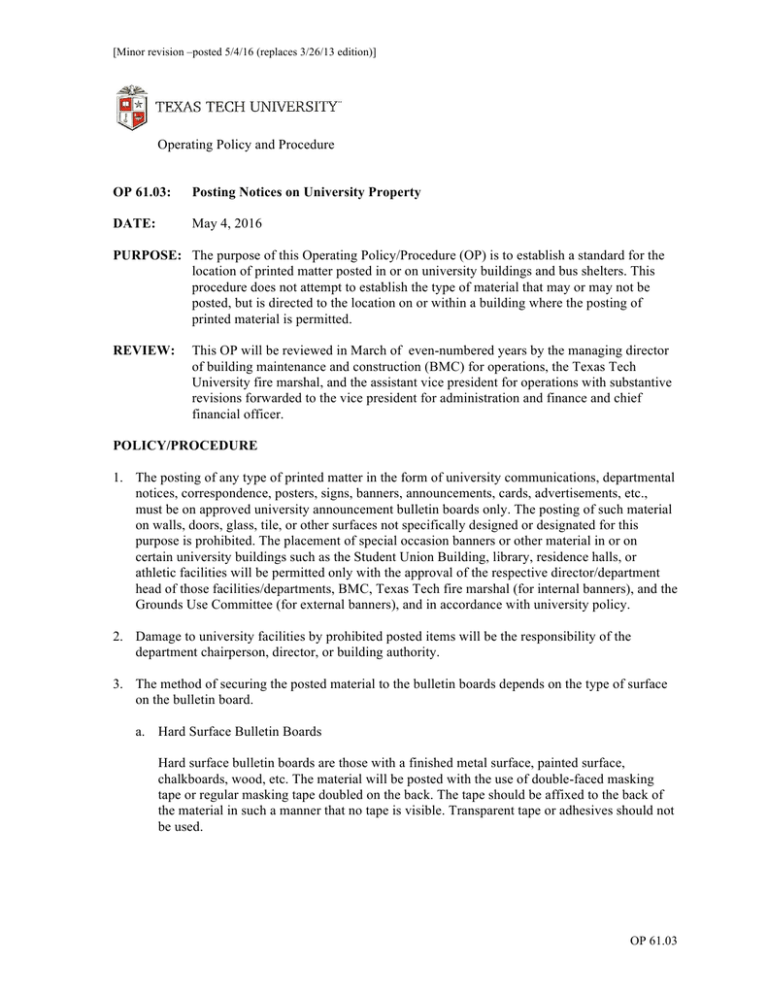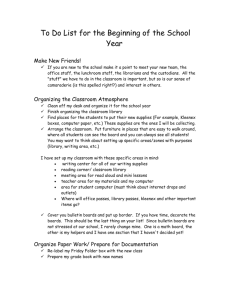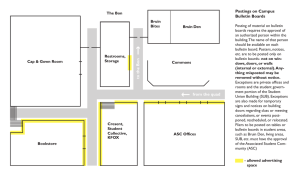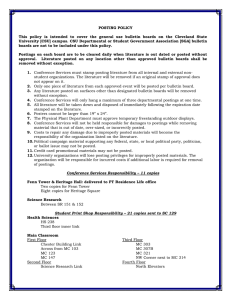Operating Policy and Procedure May 4, 2016
advertisement

[Minor revision –posted 5/4/16 (replaces 3/26/13 edition)] Operating Policy and Procedure OP 61.03: Posting Notices on University Property DATE: May 4, 2016 PURPOSE: The purpose of this Operating Policy/Procedure (OP) is to establish a standard for the location of printed matter posted in or on university buildings and bus shelters. This procedure does not attempt to establish the type of material that may or may not be posted, but is directed to the location on or within a building where the posting of printed material is permitted. REVIEW: This OP will be reviewed in March of even-numbered years by the managing director of building maintenance and construction (BMC) for operations, the Texas Tech University fire marshal, and the assistant vice president for operations with substantive revisions forwarded to the vice president for administration and finance and chief financial officer. POLICY/PROCEDURE 1. The posting of any type of printed matter in the form of university communications, departmental notices, correspondence, posters, signs, banners, announcements, cards, advertisements, etc., must be on approved university announcement bulletin boards only. The posting of such material on walls, doors, glass, tile, or other surfaces not specifically designed or designated for this purpose is prohibited. The placement of special occasion banners or other material in or on certain university buildings such as the Student Union Building, library, residence halls, or athletic facilities will be permitted only with the approval of the respective director/department head of those facilities/departments, BMC, Texas Tech fire marshal (for internal banners), and the Grounds Use Committee (for external banners), and in accordance with university policy. 2. Damage to university facilities by prohibited posted items will be the responsibility of the department chairperson, director, or building authority. 3. The method of securing the posted material to the bulletin boards depends on the type of surface on the bulletin board. a. Hard Surface Bulletin Boards Hard surface bulletin boards are those with a finished metal surface, painted surface, chalkboards, wood, etc. The material will be posted with the use of double-faced masking tape or regular masking tape doubled on the back. The tape should be affixed to the back of the material in such a manner that no tape is visible. Transparent tape or adhesives should not be used. OP 61.03 May 4, 2016 Page 2 b. Soft Surface Bulletin Boards Soft surface bulletin boards are those that have cork or other soft material surface. Thumbtacks should be used for posting material on these boards. Nails, screws, transparent tape, or adhesives should not be used on soft surface boards. 4. Most university buildings have adequate bulletin board space available. When additional space is needed, the department chairperson, director, or building authority should initiate action to increase the space. Two sizes of approved bulletin boards may be purchased from the Central Warehouse, or a Customer Project Request may be submitted to BMC to build a bulletin board to the requesting department’s specifications. Only BMC is allowed to install bulletin boards and should be in accordance with National Fire Protection Association 101 Life Safety Code® section 10.2.5.3.1, Bulletin Boards, Posters and Paper (Bulletin boards, posters, and paper attached directly to the wall shall not exceed 20 percent of the aggregate wall area to which they are applied.) 5. Notwithstanding items 1 – 4 above, the posting of signs, placards, barrier tape, and other types of similar warning materials by university entities and/or other entities having jurisdiction is permissible in locations other than those noted if there are valid reasons for such postings. The following are examples of such valid reasons: a. To ensure the health and safety of the building occupants; b. To secure the building contents; and c. To identify specific locations and prevent disturbance of materials as part of an ongoing investigation. The entity responsible for posting the warning materials shall attempt, as much as possible, to minimize the damage caused by such attachment to the interior building finishes. If possible, the warning materials should be adhered to surfaces capable of being cleaned following the posting. Following the termination of the event requiring the notification, the posting entity shall be responsible for the timely removal of the warning materials. OP 61.03




